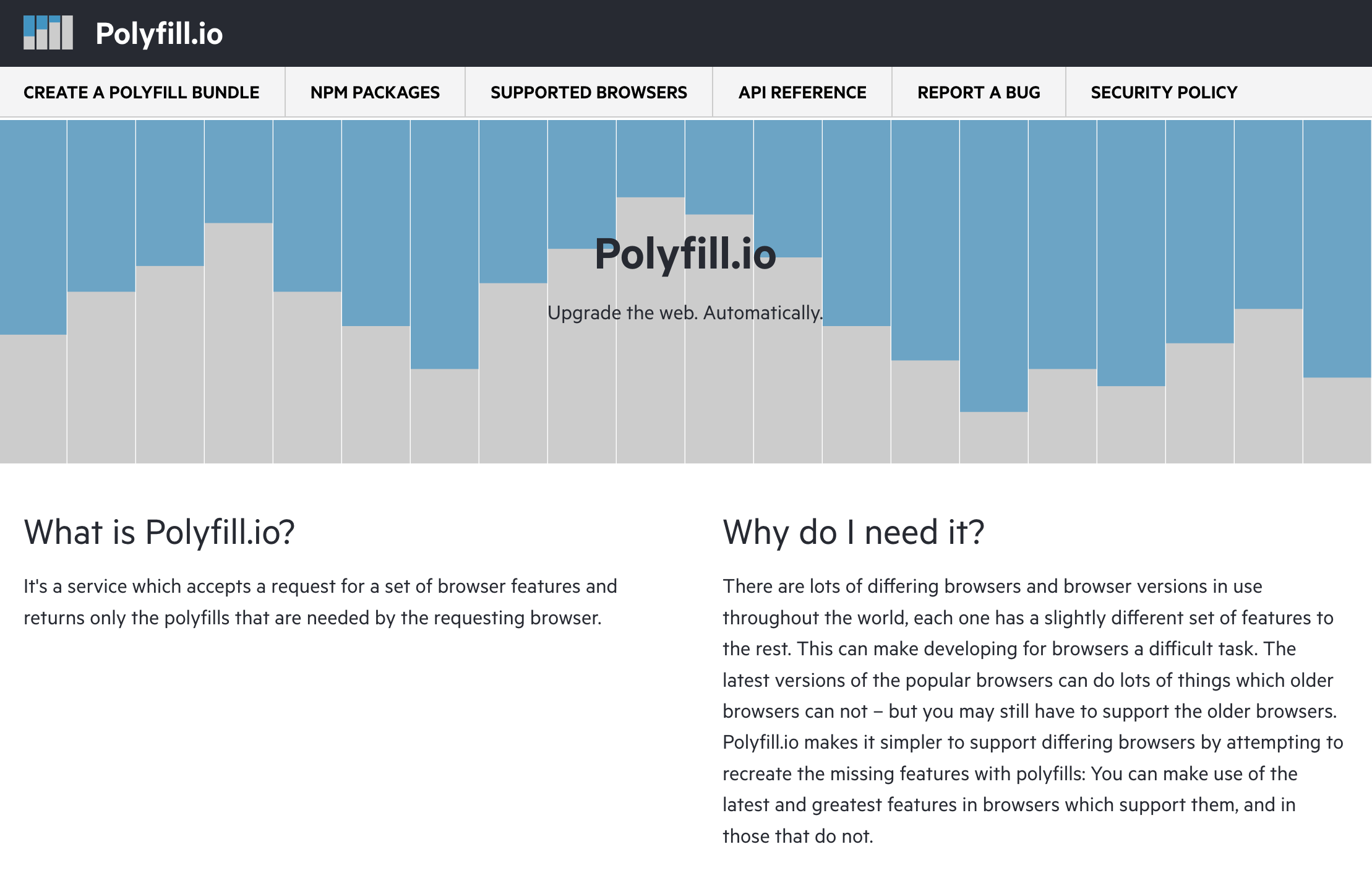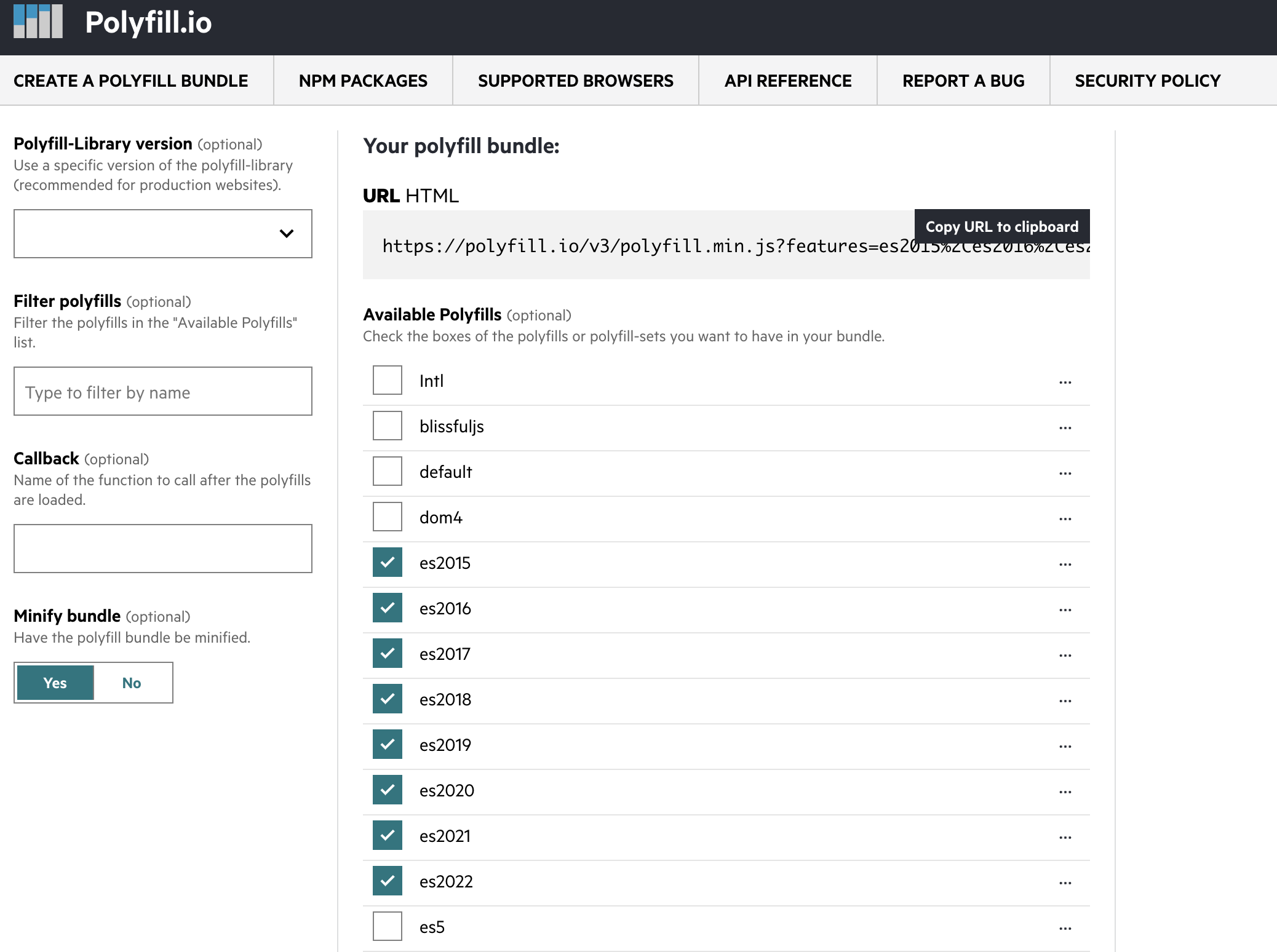
# 在项目中落地 polyfill.io
polyfill.io (opens new window)是一个根据浏览器 UA 自动生成 polyfill 的服务,polyfill.io 是开源的 (opens new window),我们可以直接使用 polyfill.io 默认提供的服务,也可以自己部署。使用 polyfill.io 这样的服务主要是用来减小打包生成文件大小,让用户尽可能的减小文件加载。
# 改造项目
通常我们的项目都是通过脚手架创建的,例如使用 vue-cli (opens new window) 或者 create-react-app (opens new window) 等。这些脚手架基本都使用 babel 来把 js 的新语法转换为 es5,同时也会根据源码中的使用的 js 新特性自动生成一些 polyfill。一份常见的babel.config.js文件如下:
module.exports = {
presets: [
[
'@babel/preset-env',
{
useBuiltIns: 'usage' // 配合 browserslist 配置,自动填充相关兼容代码,新版本babel主要会添加core-js的引用
}
]
]
}
改造第一步,在 polyfill.io 上选择需要的特性,然后复制 js 链接到 HTML 中。

<!DOCTYPE html>
<html>
<head>
<meta charset="UTF-8" />
<meta http-equiv="X-UA-Compatible" content="IE=edge" />
<meta name="viewport" content="width=device-width, initial-scale=1.0" />
<title>DEMO</title>
<script src="https://polyfill.io/v3/polyfill.min.js?features=es2016%2Ces2017%2Ces2018%2Ces2019%2Ces2020%2Ces2021%2Ces2022%2CResizeObserver%2Ces2015"></script>
</head>
<body>
<!-- 其他内容 -->
</body>
</html>
那么如果我们直接在 HTML 中引入 polyfill.io,就可能会导致同一个 polyfill 存在两份。所以我们需要把useBuiltIns修改为false。
然后我们开始打包项目。既然做了修改,那我们就对比一下打包生成的 js 的大小吧,一比较才发现,修改后的文件竟然比修改前的足足大了几百 KB。
对打包生成的文件进行分析发下,文件里面生成了很多重复的代码,例如源码为:
export default class Hello {
constructor() {
console.log('Hello')
}
sayHi() {
console.log('Hi')
}
}
生成后的文件为:
'use strict'
Object.defineProperty(exports, '__esModule', {
value: true
})
exports.default = void 0
function _classCallCheck(instance, Constructor) {
if (!(instance instanceof Constructor)) {
throw new TypeError('Cannot call a class as a function')
}
}
function _defineProperties(target, props) {
for (var i = 0; i < props.length; i++) {
var descriptor = props[i]
descriptor.enumerable = descriptor.enumerable || false
descriptor.configurable = true
if ('value' in descriptor) descriptor.writable = true
Object.defineProperty(target, descriptor.key, descriptor)
}
}
function _createClass(Constructor, protoProps, staticProps) {
if (protoProps) _defineProperties(Constructor.prototype, protoProps)
if (staticProps) _defineProperties(Constructor, staticProps)
return Constructor
}
var Hello = /*#__PURE__*/ (function() {
function Hello() {
_classCallCheck(this, Hello)
console.log('Hello')
}
_createClass(Hello, [
{
key: 'sayHi',
value: function sayHi() {
console.log('Hi')
}
}
])
return Hello
})()
exports.default = Hello
我们可以看到生成的文件中包含了_classCallCheck、_defineProperties、_createClass等内容,检查多个文件后发现,每个包含class的源文件生成的代码都包含了前面的这几个函数,他们之间没有被复用。
为啥 helper 函数不能被复用呢?这里和@babel/plugin-transform-runtime这个插件有关,这个插件的官方文档是这样说的,`A plugin that enables the re-use of Babel's injected helper code to save on codesize.(一个可以重复使用 Babel 的注入的 helper 代码来节省代码大小插件。)”,经过一番文档查阅,变更后的 babel 配置如下:
module.exports = {
presets: [
[
'@babel/preset-env',
{
useBuiltIns: false // 不注入polyfill
}
]
],
plugins: [
[
'@babel/plugin-transform-runtime',
{
absoluteRuntime: false,
// 不使用 @babel/runtime-corejs2 或 @babel/runtime-corejs3,这里不设置就是用 @babel/runtime
corejs: false,
helpers: true,
// generator 相关的运行时helper
regenerator: true,
// version 不同,复用的helper范围会不一样,请使用最新版本@babel/runtime,版本越新,helper会越多,默认7.0.0-beta.0
version: require('@babel/runtime/package.json').version
}
]
]
}
注意:@babel/plugin-transform-runtime不能当做 polyfill 去使用,它主要是提供一些babel 编译helper,例如语法层面的转换函数;polyfill 是提供一些兼容 API,例如Array.prototype.flat等。这是@babel/plugin-transform-runtime官方给的提示。
NOTE: Instance methods such as "foobar".includes("foo") will only work with core-js@3. If you need to polyfill them, you can directly import "core-js" or use @babel/preset-env's useBuiltIns option.
# 结论
改造为使用 polyfill.io 需要修改@babel/preset-env的useBuiltIns参数来禁止自动填充 polyfill,并且要使用@babel/plugin-transform-runtime来复用 babel 编译过程中生成的 helper 函数